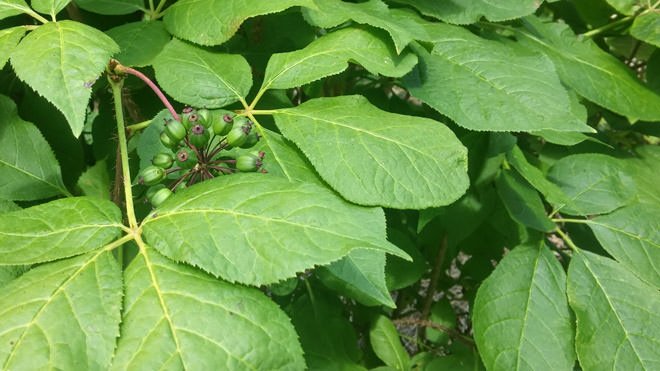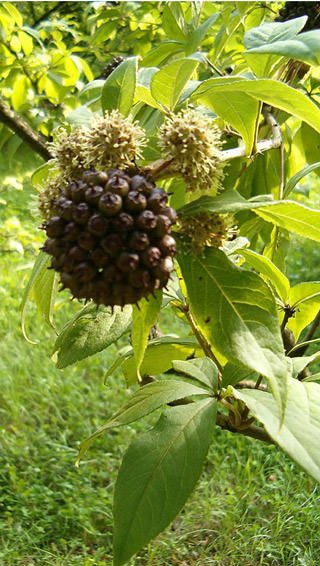Also commonly called Siberian ginseng, eleuthero is a revered adaptogen that can support the body during physical or mental stress and alleviate exhaustion and depression. It's also used in conjunction with chemotherapy. Roots are harvested in the fall to make the medicinal extract from.

Photo by @krnel
Eleuthero is originally an Asian herb that's been used for thousands of years in folk medicine. Formerly called Siberian ginseng, the name was changed to avoid confusion with the true American (Panax quinquefolius) or Asian (Panax ginseng) ginseng plant. This ginseng relative is less researched for it's health effects, making it less prized and less expensive.
Key Points
- not a true ginseng, but a relative
- thousands of years of use in folk medicine
- little scientific proof done to validate claims
- anxiety and depression relief
History
The scientific name is Eleutherococcus senticosus, but is also called Acanthopanax Obovatus, Acanthopanax Obovatus Hoo, Acanthopanax senticosus, Buisson du Diable, Ci Wu Jia, Ciwujia, Ciwujia Root, Ciwujia Root Extract, Devil's Bush, Devil's Shrub, Éleuthéro, Eleuthero Extract, Eleuthero Ginseng, Eleuthero Root, Eleutherococci Radix, Eleutherococcus senticosus, Éleuthérocoque, Ginseng de Sibérie, Ginseng des Russes, Ginseng Root, Ginseng Siberiano, Ginseng Sibérien, Hedera senticosa, North Wu Jia Pi, Phytoestrogen, Plante Secrète des Russes, Poivre Sauvage, Prickly Eleutherococcus, Racine d’Eleuthérocoque, Racine de Ginseng, Racine Russe, Russian Root, Shigoka, Siberian Eleuthero, Siberian Ginseng, Thorny Bearer of Free Berries, Touch-Me-Not, Untouchable, Ussuri, Ussurian Thorny Pepperbrush, Wild Pepper, Wu Jia Pi, Wu-jia.
The name Eleutherococcus is Greek, meaning "free-berried", and senticosus is Latin, meaning thorn-bush, briar.
Where is it found?
It forms low undergrowths in mountain forests, sometimes at the foot of cliffs in oak groves. Native to East Asia, China, Japana and Russia. It tolerates all types of soils like sandy, loamy, and heavy clay soils, with any type of alkalinity, including soils of low nutritional value.
What's it used for?
The root extract has including lignans, sesamin (eleutheroside B4), syringaresinol, phenylpropanes, coumarins, beta-sitosterol and daucosterol. The berries have polyphenols such as caffeic acid, vanillic acid, ferulic acid, p-coumaric acid, and benzoic acid, with significant content of calcium, magnesium, and potassium.
Main uses:
- heart disease prevention
- anxiety relief
- depression relief
- recovery from stress burnout
Eleuthero is called an "adaptogen", which is a non-medical term to refer to a substance that is supposed to strengthen the body and increase stress resistance. It's also used for the heart and blood vessels such as high blood pressure, low blood pressure, hardening of the arteries (atherosclerosis), rheumatic heart disease, kidney disease, Alzheimer’s disease, attention deficit-hyperactivity disorder (ADHD), chronic fatigue syndrome, diabetes, fibromyalgia, rheumatoid arthritis, flu, colds, chronic bronchitis, tuberculosis and in treating the effects of chemotherapy such as increasing appetite.
As an adaptogen, it's used for boosting the immune system and prevent colds. Some use it for increasing performance, to treat sleeping issues like insomnia and for symptoms of herpes simplex type 2.
Are there any risks?
It's likely safe for oral short term use, with rare side effects which could include drowsiness, changes in heart rhythm, sadness, anxiety, and muscle spasms. High doses can increase blood pressure. Long-term oral use is possibly safe, as well as short-term IV injection for two weeks.
It's also possibly safe for children, but unknown for pregnant women and those breast feeding. Issues may arise for those with bleeding disorders as it might slow blood clotting or increase the risk of bruising. Eleuthero can cause high blood pressure, irregular heartbeat and pounding heart, and should be avoided if a heart condition exists. There are warning of use for those with mental conditions like mania or schizophrenia. The risks as well as the benefits aren't scientifically proven.
References:
Previous posts on Getting to Know Herbs:
Black Cohosh | Common Bearberry | Mahonia Mountain Grape (Oregon Grape) | Blue Cohosh | Goldenseal
Thank you for your time and attention. Peace.
If you appreciate and value the content, please consider: Upvoting, Sharing or Reblogging below.
 me for more content to come!
me for more content to come!
My goal is to share knowledge, truth and moral understanding in order to help change the world for the better. If you appreciate and value what I do, please consider supporting me as a Steem Witness by voting for me at the bottom of the Witness page.


